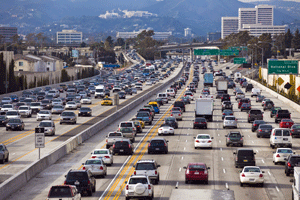 The rate of congestion, road and bridge deterioration in the California Interstate system is among the highest in the country, according to a report released this week.
The rate of congestion, road and bridge deterioration in the California Interstate system is among the highest in the country, according to a report released this week.
The report, Restoring the Interstate Highway System: Meeting America’s Transportation Needs with a Reliable, Safe & Well-Maintained National Highway Network, looks at the U.S. Interstate system’s use, condition and benefits, and the findings of a 2019 report prepared by the Transportation Research Board (TRB), at the request of Congress as part of the Fixing America’s Surface Transportation (FAST) Act, on the condition and use of the Interstate system and on actions required to restore and upgrade it.
The report shows that the national Interstate system has a persistent and growing backlog of physical and operational deficiencies as a result of age, heavy use and deferred reinvestment, and is in need of major reconstruction and modernization. The conclusion: annual investment in the nation’s Interstate Highway System should be increased approximately two-and-a-half times, from $23 billion in 2018 to $57 billion annually over the next 20 years.
“Investing in our transportation infrastructure is a win-win,” said Allan Zaremberg, president and CEO of the California Chamber of Commerce. “It will get essential products to Californians and allow people to travel to work and school in a safer environment while providing much-needed jobs to improve California’s economy. California’s transportation infrastructure is the backbone of our economy.”
California
The report ranks state Interstate systems based on traffic congestion; increase in vehicle miles of travel (VMT) since 2000; share of commercial trucks carried; share of pavement in poor condition; bridges in poor/structurally deficient condition; and fatality rates.
On those metrics, California ranked No. 1 for most congested, No. 9 for poor condition of pavement, and No. 11 for bridges being in poor/structurally deficient condition.
Since 2000, travel on the U.S. Interstate system, the importance of which has been heightened during the COVID-19 pandemic, has increased at a rate nearly triple that at which new lane capacity is being added. In California, 86% of urban Interstate highways are considered congested during peak hours, the greatest share in the U.S., the report shows. Vehicle travel on California’s Interstates increased 17% from 2000 to 2018. Eight percent of Interstate travel in California is by combination trucks.
The design of the Interstate—which includes a separation from other roads and rail lines, a minimum of four lanes, paved shoulders and median barriers—makes California’s Interstates twice as safe to travel on as all other roadways. The fatality rate per 100 million vehicle miles of travel on California’s Interstate in 2018 was 0.58, compared to 1.18 on the state’s non-Interstate routes, according to the report.
Funding Decreasing
Allocating funding to the state’s and nation’s infrastructure is critical at the moment, the report points out, as the system faces a double whammy of decreased revenue due to the COVID-19 pandemic, and the expiration of the FAST Act.
The FAST Act is the primary source of revenue for the Interstate Highway System and is used by states to fund transportation infrastructure planning and investment. The FAST Act is set to end on September 30, 2020.
The COVID-19 pandemic also has affected states’ abilities to pay for infrastructure repair.
“The ability of states to invest in Interstate highway repairs and improvements may be hampered by the tremendous decrease in vehicle travel that has occurred due to the COVID-19 pandemic, which the American Association of State Highway and Transportation Officials estimates will reduce state transportation revenues by at least 30 percent—approximately $50 billion—over the next 18 months,” the report states.


